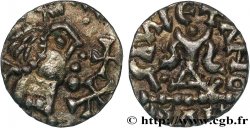bmv_321975 - MEROVINGIAN COINAGE - BANASSAC (BANNACIACO) - Lozere Triens aux deux croix
недоступный.
Товар уже продан в нашем интернет-магазине (2014)
Цена: : 2 200.00 €
Товар уже продан в нашем интернет-магазине (2014)
Цена: : 2 200.00 €
Тип Triens aux deux croix
Дата: (VIIe siècle)
Монетный двор / Город: Banassac
Металл: gold
Диаметр: 12,5 mm
Ориентация осей монеты: 3 h.
Вес: 1,05 g.
Редкость: R3
Комментарии о состоянии
Magnifique monnaie bien frappée sur un flan en bon or. Bons reliefs et bon centrage, avec toutes les légendes et tous les détails visibles
Ссылки в каталоге: :
Лицевая сторона
Аверс: легенда: ANÉPIGRAPHE.
Аверс: описание: Tête barbare diadémée, à droite ; diadème et cou perlés ; deux croisettes et deux globules alternés devant le visage.
Обратная сторона
Реверс: легенда: GAVALETANO // BAH.
Реверс: Описание: Calice à deux anses, posé sur une ligne d’exergue perlée.
Комментарий
Les triens de ce type sont attribués à SIGEBERT et sont relativement abondants ce qui a permis d'en réaliser une étude précise, avec des différenciations parfois subjectives ! Cet exemplaire appartient à la série L, "Avec deux croix et deux globules" ; un seul triens de ce type figure dans le Belfort sous le n° 763, en signalant un exemplaire à la BN et un autre au musée de Metz.
Cet exemplaire présente aussi une petite croisette à gauche de la ligne d’exergue au revers ; ce motif vient s’ajouter aux deux globules de part et d’autre de la base du calice.
Cet exemplaire présente aussi une petite croisette à gauche de la ligne d’exergue au revers ; ce motif vient s’ajouter aux deux globules de part et d’autre de la base du calice.








 Cообщить об ошибке
Cообщить об ошибке Распечатать страницу
Распечатать страницу Отправить мой выбор
Отправить мой выбор Задать вопрос
Задать вопрос Consign / sell
Consign / sell
 Информация
Информация












